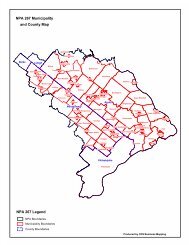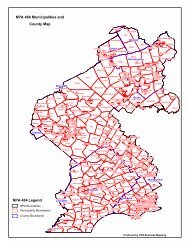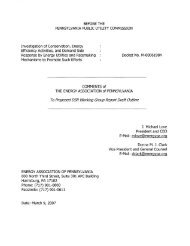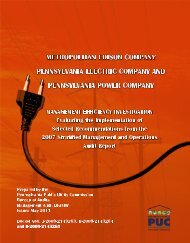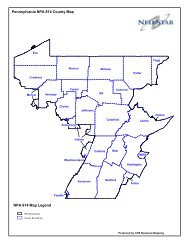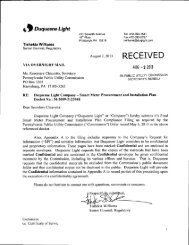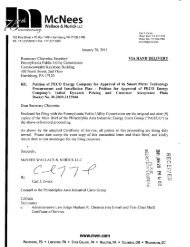2010 Report - Pennsylvania Public Utility Commission
2010 Report - Pennsylvania Public Utility Commission
2010 Report - Pennsylvania Public Utility Commission
You also want an ePaper? Increase the reach of your titles
YUMPU automatically turns print PDFs into web optimized ePapers that Google loves.
The MISO reserve margin for existing capacity resources is 21,669 MW for 2009, which is 21.6percent, based on net internal demand. With an additional 424 MW of planned new capacity, thereserve margins are expected to meet the 15.4 percent target through 2014. If the likely portion ofproposed capacity additions is included, the reserve margin target is expected to be maintainedthrough 2018.Uncertain resources are not included when determining the reserve margin. Uncertain resourcesare the existing generation that represents wind/variable resource deratings, generating capacitythat has not been studied for delivery within the RTOs, and capacity located within the region thatis not part of PJM or MISO committed capacity. Conceptual capacity represents less certain futurecapacity additions and only a portion of the capacity is included when determining the expectedreserve margins.The amount of available wind power capability included in the reserve calculations is less than thenameplate rating of the wind resources. PJM has recently changed the default wind capabilityfrom 20 percent to 13 percent for new queue projects. MISO permits wind power providers todeclare up to 20 percent of nameplate capability as a capacity resource.The fuel mix of generating units in the RFC region is 15.0 percent nuclear, 3.0 percentconventional and pumped storage hydro, 47.0 percent coal, 6.0 percent oil, 28.0 percent gas, and1.0 percent wind and other. Since there currently are no adverse conditions affecting the resourceswithin the RFC region, the RFC assessment assumes that any future adverse weather or fuel supplyissues would be temporary in duration and limited in impact on resource availability, and will notaffect the long-term assessment.Within the PJM footprint, the capacity mix is likely to shift to more natural gas-fired combinedcycle and combustion turbine capacity. Continued reliance on steam (mainly coal) appears likely,although potential changes in environmental regulations may have an impact on coal unitsthroughout the footprint.Over the next seven years, there are plans within the RFC region for the addition of more than1,700 miles of high-voltage transmission lines (100 kV and above), and numerous new substationsand transformers expected to enhance and strengthen the bulk transmission system. PJM’s RTEPhas identified four major “backbone” projects, two of which were mentioned earlier.The Trans-Allegheny Interstate Line, scheduled for operation in 2011, consists of a new 500 kVcircuit from 502 Junction to Mt. Storm to Meadow Brook to Loudon. This project will relieveanticipated overloads and voltage problems in the Washington, D.C., area, including anticipatedoverloads expected in 2011 on the existing 500 kV network.The planned 130-mile, 500 kV circuit from Susquehanna to Lackawanna to Roseland will tie intothe existing 500 kV network and, with the addition of 500/230 kV transformers, will create astrong link from generation sources in Northeastern and North Central <strong>Pennsylvania</strong> into NewJersey. These facilities are expected to be in service by June 2012.68<strong>Pennsylvania</strong> <strong>Public</strong> <strong>Utility</strong> <strong>Commission</strong>



